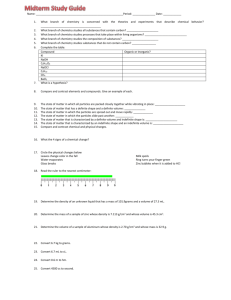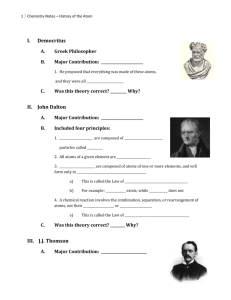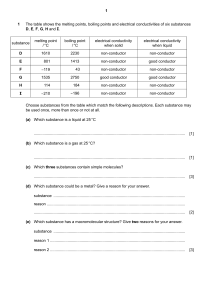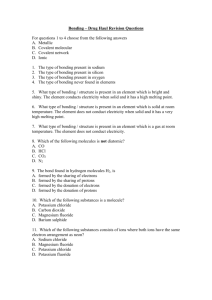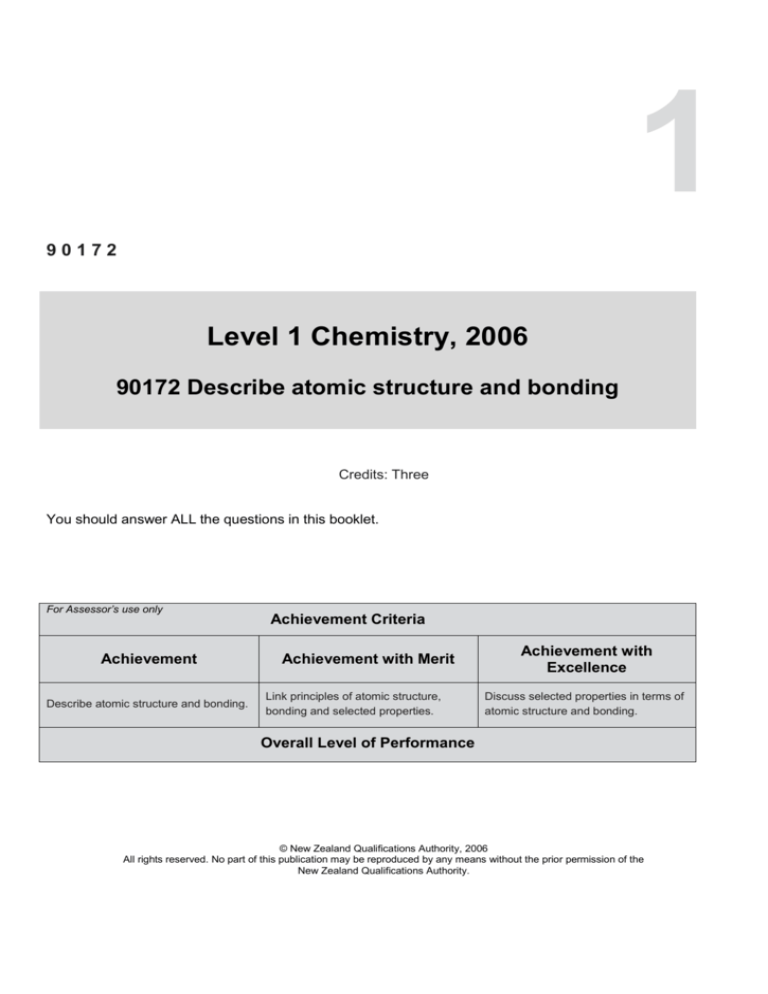
1
90172
Level 1 Chemistry, 2006
90172 Describe atomic structure and bonding
Credits: Three
You should answer ALL the questions in this booklet.
For Assessor’s use only
Achievement
Describe atomic structure and bonding.
Achievement Criteria
Achievement with Merit
Link principles of atomic structure,
bonding and selected properties.
Achievement with
Excellence
Discuss selected properties in terms of
atomic structure and bonding.
Overall Level of Performance
© New Zealand Qualifications Authority, 2006
All rights reserved. No part of this publication may be reproduced by any means without the prior permission of the
New Zealand Qualifications Authority.
You are advised to spend 30 minutes answering the questions in this booklet.
QUESTION ONE
Use the table below to answer the questions (a) to (e) that follow:
Element
Mass Number
Sodium
Atomic
Number
11
Potassium
19
39
Oxygen
8
16
Sulfur
16
32
23
(a)
What is the chemical symbol for the potassium atom?
(b)
Write the electron arrangement for the potassium atom.
(c)
State the number of neutrons in the sodium atom.
(d)
What do the electron arrangements of oxygen and sulfur have in common?
(e)
Write the electron arrangement for the oxide ion.
L1 Chemistry 2006, 90172 – page 2 of 5
QUESTION TWO
Oxygen has three isotopes with mass numbers 16, 17 and 18.
Complete the following table:
Number of particles present in the nucleus
Isotope
protons
16
O
17
O
18
O
neutrons
QUESTION THREE
All of the following elements, except one, have similar chemical properties.
(a)
Circle the ONE element that is the exception.
Mg
(b)
Ca
O
Sr
Use the positions of the atoms on the periodic table and electron arrangements of the atoms to justify
your choice in (a).
L1 Chemistry 2006, 90172 – page 3 of 5
QUESTION FOUR
The Lewis diagram for a hydrogen chloride molecule can be drawn as:
Draw the Lewis diagrams for the atoms or molecules given in each of the boxes below:
(a)
Nitrogen atom, N
(b)
Chlorine molecule, Cl2
(c)
Water, H2O
(d)
Phosphorus trichloride, PCl3
(e)
Nitrogen molecule, N2
(f)
Carbon disulfide molecule, CS2
L1 Chemistry 2006, 90172 – page 4 of 5
QUESTION FIVE
The following table shows the electrical conductivity of two substances in their solid and liquid states.
Name of substance
Electrical conductivity of the substance
Solid state
Liquid state
sodium chloride (NaCl)
Non-conductor
Conductor
sulfur dichloride (SCl2)
Non-conductor
Non-conductor
Discuss the differences in electrical conductivity of these two substances in both states of matter.
Your discussion should include the types of particles that make up these substances, and the forces between
them in the solid and liquid states.
QUESTION SIX
Of the two substances chlorine (Cl2) and potassium chloride (KCl), one is a gas and the other is solid at
room temperature.
Discuss the state of each substance at room temperature, in terms of the types of particles that make up these
substances, and the attractive forces between these particles.
You should include in your answer information on particle separation, energy, and particle motion.
(a)
Chlorine
(b)
Potassium Chloride
L1 Chemistry 2006, 90172 – page 5 of 5






